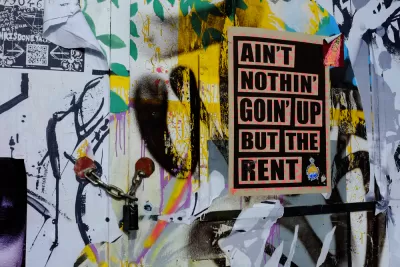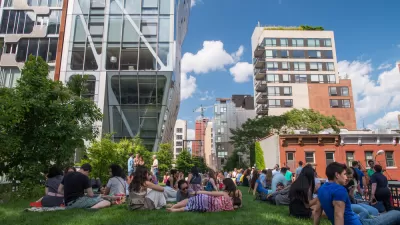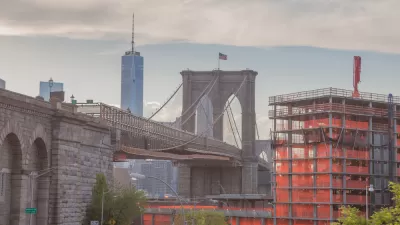In his new book, Richard Florida worries about segregation and redefines "the creative class."

Richard Florida is famous for writing about the "creative class"—often stereotyped as liberal-minded urban young people. But in his new book The New Urban Crisis, Florida goes in a very different direction. He redefines the creative class as the educated upper classes; for example, his maps of various metro areas frequently describe affluent outer suburbs as "creative class" neighborhoods.
What is the "Crisis" Florida writes about? Primarily the exploding cost of living in high-growth "superstar" metro areas, and the highly related growth of income inequality and residential segregation.
Like many other commentators (including this one), Florida emphasizes the negative affects of NIMBYism. He points out that homeowners "have more to gain from increasing the scarcity of usable land than from maximizing its productive and economically beneficial uses." As a result, they support zoning restrictions that artificially limit supply. Florida goes even further, suggesting that these policies harm the economy as a whole. For example, if "everyone who wanted to work in San Francisco could afford to live there, the city would see a 500 percent increase in jobs...On a national basis, [similar results] would add up to an annual wage increase of $8775 for the average worker, adding 13.5 percent to America's GNP — a total gain of nearly $2 trillion" (p 27).
But on the very next page, Florida criticizes the idea that "we can make our cities more affordable... simply by getting rid of existing land use restrictions" because "the high cost of land in superstar neighborhoods makes it very hard if not impossible, for the private market to create affordable housing in their vicinity. Combine the high costs of land with the high costs of high-rise construction and the result is more high-end luxury housing." (p. 28).
On the other hand, land prices are often quite volatile. More importantly, the overwhelming majority of any region's housing is not particularly new; even in high-growth Houston, only 2 percent of housing units were built after 2010. Thus, new market-rate housing is likely to lower rents by affecting the price of older housing, rather than by bringing new cheap units into the market. So even if market-rate housing is expensive, it can still stabilize the costs of older housing. Having said that, I don't think Florida is against less regulation; rather, he seems to be saying that reducing regulation can have a role in stabilizing housing prices, but should be combined with other policies, such as a land value tax.
Florida also writes that "too much density can actually deaden neighborhoods" because "The world's most innovative and creative places are not the high-rise canyons of Asian cities but the walkable, mixed-use neighborhoods in San Francisco, New York and London" (p. 28). Does this mean that places with high-rises cannot be walkable and mixed-use? Or that New York has no "high-rise canyons."? And what evidence is there that Asian cities are less "creative" than American ones?* Since Florida does not explain these point, I am not quite sure what he is thinking.
Florida moves on to discuss inequality; he begins by pointing out that high-cost places are actually a pretty good deal for the average worker, even with high rents. For example, in San Francisco and New York, the average worker has $40-46,000 left over after paying for housing, while in high-growth, low-cost Virginia Beach, Orlando, and Las Vegas, the average worker has only $25-29,000 left over after paying for housing. This is especially the case for "Creative Class" workers (defined on p. 217 as workers in a wide variety of listed occupations); the average creative class worker has $71,141 in (for example) San Francisco as opposed to $50-55,000 in these low-cost metros. On the other hand, workers in routine service jobs come out only slightly ahead in San Francisco; they get $16,806 after paying for housing in San Francisco as opposed to $12-15,000 in the three low-cost cities.
I was surprised to read that workers are better off in a high-cost metro area but have two concerns. First, if Florida used median wages instead of average wages, would workers still be better off in high-cost region—or is the apparent high income of these cities' workers a result of a few high earners inflating regional averages? Second, is the quality of housing comparable in high-growth areas—or is the average San Francisco worker living with roommates while his or her Virginia Beach counterpart buys a large condo or house?
Florida then devotes a chapter to inequality; he writes that this problem is most acute in "large, dense, knowledge-based metros." However, his data reveals a more complicated picture. One measure of inequality is the Gini coefficient; by this measure the most unequal metros include not only dense New York, San Francisco and Boston but also sprawling Birmingham, Memphis and Houston. At any rate, Florida could explain more clearly why this matters; he writes that "the same factors that drive economic growth also drive inequality" (p. 88) but "A high level of income inequality ...can be, and often is, a drag on economic growth." (p. 90) I am not sure how these two statements fit together.
Florida also worries about segregation; he writes that the creative class is most segregated in "tech hubs and superstar cities" (p 108). But his own charts make it clear that other types of segregation are stronger in not-so-gilded metros. For example, segregation of the poor is highest in Rust Belt metros: Florida lists the five worst large metros in this regard as Milwaukee, Hartford, Philadelphia, Cleveland and Detroit- all areas with slow-growth or declining central cities (p. 101). It is not clear to me why the first type of segregation is more harmful than the second.
Near the end of the book, Florida includes a chapter on the "global urban crisis." He asserts that while economic development has historically "gone hand in hand with urbanization....The connection between urbanization and growth has now become much more tenuous, producing a troubling new pattern of 'urbanization without growth.'"(p. 174). But just a page later, he writes that "even if urbanization isn't a surefire recipe for prosperity, it is still better than the alternative" (p. 175). He writes that third-world cities tend to be far more productive than their rural hinterlands; while the typical large U.S. metro is at most 50 percent more productive than the national average, many Third World metros are two or three or even ten times as productive as their national averages. So what's Florida's point? I think he is trying to say that Third World urbanization on balance makes people better off, but that the status quo could be improved upon.
His final chapter is entitled "Urbanism for All": this is mostly a grab-bag of policies generally favored by liberals (e.g., more public transit, more housing vouchers, some form of a guaranteed basic income for all). However, he is less pro-regulation than the most extreme progressives, suggesting that rent control might discourage renovation of rental properties and that inclusionary zoning is likely to increase housing supply only in the hottest markets. To put it another way, Florida's instincts seem to be moderately but not extremely liberal; he favors lots of government spending on infrastructure and poverty reduction, but worries about strangling the private sector with overregulation.
*In fairness, Florida does point out elsewhere in his book that the most prosperous American metros get more venture capital investment than Shanghai or Beijing (p. 44)—but this is equally true of not-so-walkable Los Angeles and San Diego, so the notion that low-rise urbanism causes this difference strikes me as highly questionable. Moreover, the fact that the United States is generally a much wealthier country than China might be relevant to this issue.

Study: Maui’s Plan to Convert Vacation Rentals to Long-Term Housing Could Cause Nearly $1 Billion Economic Loss
The plan would reduce visitor accommodation by 25,% resulting in 1,900 jobs lost.

North Texas Transit Leaders Tout Benefits of TOD for Growing Region
At a summit focused on transit-oriented development, policymakers discussed how North Texas’ expanded light rail system can serve as a tool for economic growth.

Using Old Oil and Gas Wells for Green Energy Storage
Penn State researchers have found that repurposing abandoned oil and gas wells for geothermal-assisted compressed-air energy storage can boost efficiency, reduce environmental risks, and support clean energy and job transitions.

Santa Barbara Could Build Housing on County Land
County supervisors moved forward a proposal to build workforce housing on two county-owned parcels.

San Mateo Formally Opposes Freeway Project
The city council will send a letter to Caltrans urging the agency to reconsider a plan to expand the 101 through the city of San Mateo.

A Bronx Community Fights to Have its Voice Heard
After organizing and giving input for decades, the community around the Kingsbridge Armory might actually see it redeveloped — and they want to continue to have a say in how it goes.
Urban Design for Planners 1: Software Tools
This six-course series explores essential urban design concepts using open source software and equips planners with the tools they need to participate fully in the urban design process.
Planning for Universal Design
Learn the tools for implementing Universal Design in planning regulations.
Ascent Environmental
Borough of Carlisle
Institute for Housing and Urban Development Studies (IHS)
City of Grandview
Harvard GSD Executive Education
Toledo-Lucas County Plan Commissions
Salt Lake City
NYU Wagner Graduate School of Public Service





























